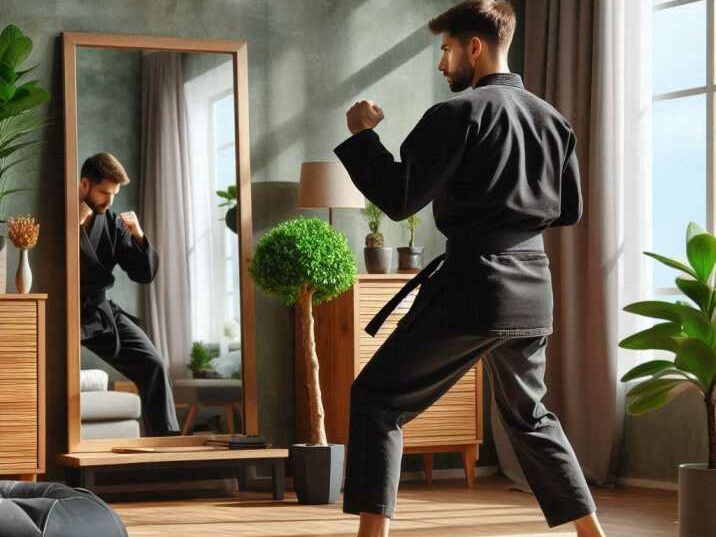Introduction
Table of Contents
Welcome to our ultimate guide on how to learn Krav Maga at home. If you’ve ever been fascinated by this dynamic self-defense system but felt constrained by time, location, or finances, this post is your perfect starting point. By the end of this guide, you’ll have a solid understanding of Krav Maga’s fundamentals, practical training techniques, and resources to effectively practice at home. Whether you’re a complete beginner or looking to refine your skills, this comprehensive guide is designed to help you master Krav Maga from the comfort of your living space.

What is Krav Maga?
Krav Maga, which translates to “contact combat” in Hebrew, is a self-defense system developed for the Israeli military. It combines elements from various martial arts and fighting styles, including boxing, wrestling, judo, and karate, with a focus on real-world situations and efficiency. The primary goal of Krav Maga is to neutralize threats quickly and effectively, making it ideal for self-defense.
Why Learn Krav Maga at Home?
Learning Krav Maga at home offers several advantages:
- Flexibility: Train at your own pace and schedule, fitting sessions around your lifestyle.
- Cost-Effective: Save money on gym memberships and class fees.
- Comfort: Practice in a familiar and comfortable environment.
- Privacy: Learn without the pressure of a class setting, especially beneficial for beginners.
Setting Up Your Home Training Space
Before diving into the techniques, it’s crucial to set up an effective training space at home. Here’s what you’ll need:
- Open Space: Clear an area with enough room to move freely. A living room, garage, or backyard can work well.
- Mats: Invest in some soft mats to protect yourself during falls and ground techniques.
- Mirrors: Use mirrors to check your form and technique.
- Equipment: Basic equipment like focus mitts, a punching bag, and resistance bands can enhance your training.
The Fundamentals of Krav Maga
Basic Stances and Movements
- Fighting Stance: Stand with your feet shoulder-width apart, knees slightly bent, and hands up protecting your face. This stance allows for quick movement and balance.
- Footwork: Practice moving forward, backward, and side-to-side while maintaining your stance. Good footwork is essential for both offense and defense.
Basic Strikes
- Straight Punch: From your fighting stance, extend your fist straight towards your target, rotating your hips and shoulders for power.
- Palm Heel Strike: Similar to a straight punch, but striking with the base of your palm, which is less likely to injure your hand.
- Elbow Strike: Use the hard point of your elbow to strike targets at close range.
Basic Kicks
- Front Kick: Lift your knee and extend your foot forward, striking with the ball of your foot.
- Roundhouse Kick: Swing your leg in a circular motion, striking with the shin or instep.
Self-Defense Techniques
Defending Against Common Attacks
- Choke Defense: If someone grabs your throat, bring your hands up to your neck, step back, and use your body weight to break free.
- Bear Hug Defense: Lower your center of gravity and use your elbows to strike the attacker’s face or body.
Training Drills
Solo Drills
- Shadowboxing: Practice your strikes and movements without a partner, focusing on technique and speed.
- Mirror Drills: Use a mirror to monitor your form and make corrections.
Partner Drills
- Pad Work: Practice strikes and combinations with a partner holding focus mitts or pads.
- Scenario Training: Simulate real-life attack scenarios with a partner to practice defense techniques.
Advanced Techniques
Ground Defense
- Guard Position: Learn how to defend and attack from your back.
- Escape Techniques: Practice escaping from various holds and chokes on the ground.
Weapon Defense
- Knife Defense: Techniques to disarm and neutralize an attacker with a knife.
- Gun Defense: Strategies to safely disarm an attacker with a firearm.
Resources for Learning Krav Maga at Home
- Online Courses: Websites like MasterClass and Krav Maga Worldwide offer comprehensive online courses.
- Books: Titles like “Krav Maga: An Essential Guide to the Renowned Method” by David Kahn provide detailed instruction.
- YouTube Channels: Channels like “Krav Maga Training” offer free tutorials and drills.
Staying Motivated
- Set Goals: Outline specific, achievable goals for your training.
- Track Progress: Keep a training journal to monitor your improvements.
- Join Online Communities: Connect with other Krav Maga enthusiasts for support and advice.
Conclusion
Learning Krav Maga at home is a practical and rewarding way to develop self-defense skills, improve fitness, and boost confidence. With the right resources, dedication, and a structured approach, you can effectively master Krav Maga from your living space. Start your journey today and empower yourself with the knowledge and skills to protect yourself and your loved ones.
FAQs
Can I learn Krav Maga at home without any prior experience?
Yes, beginners can start learning Krav Maga at home with the right resources and dedication.
What equipment do I need to learn Krav Maga at home?
Basic equipment includes mats, focus mitts, a punching bag, and resistance bands.
How often should I train Krav Maga at home?
Aim for at least 3-4 sessions per week, with each session lasting 45-60 minutes.
Is Krav Maga effective for self-defense?
Yes, Krav Maga is highly effective for real-world self-defense situations.
Can I learn Krav Maga from online courses?
Yes, many reputable online courses offer comprehensive Krav Maga training.


